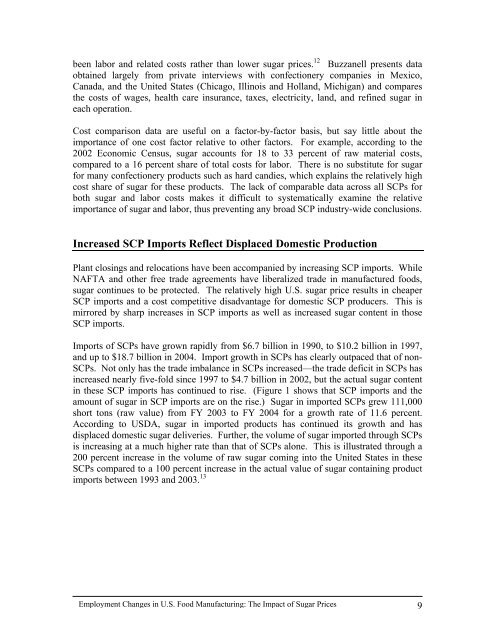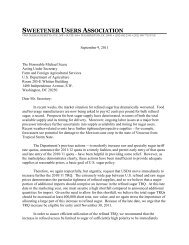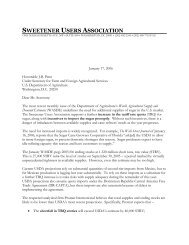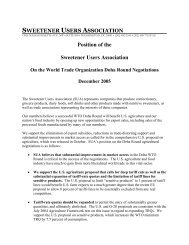Employment Changes in US Food Manufacturing - Coalition for ...
Employment Changes in US Food Manufacturing - Coalition for ...
Employment Changes in US Food Manufacturing - Coalition for ...
Create successful ePaper yourself
Turn your PDF publications into a flip-book with our unique Google optimized e-Paper software.
een labor and related costs rather than lower sugar prices. 12 Buzzanell presents data<br />
obta<strong>in</strong>ed largely from private <strong>in</strong>terviews with confectionery companies <strong>in</strong> Mexico,<br />
Canada, and the United States (Chicago, Ill<strong>in</strong>ois and Holland, Michigan) and compares<br />
the costs of wages, health care <strong>in</strong>surance, taxes, electricity, land, and ref<strong>in</strong>ed sugar <strong>in</strong><br />
each operation.<br />
Cost comparison data are useful on a factor-by-factor basis, but say little about the<br />
importance of one cost factor relative to other factors. For example, accord<strong>in</strong>g to the<br />
2002 Economic Census, sugar accounts <strong>for</strong> 18 to 33 percent of raw material costs,<br />
compared to a 16 percent share of total costs <strong>for</strong> labor. There is no substitute <strong>for</strong> sugar<br />
<strong>for</strong> many confectionery products such as hard candies, which expla<strong>in</strong>s the relatively high<br />
cost share of sugar <strong>for</strong> these products. The lack of comparable data across all SCPs <strong>for</strong><br />
both sugar and labor costs makes it difficult to systematically exam<strong>in</strong>e the relative<br />
importance of sugar and labor, thus prevent<strong>in</strong>g any broad SCP <strong>in</strong>dustry-wide conclusions.<br />
Increased SCP Imports Reflect Displaced Domestic Production<br />
Plant clos<strong>in</strong>gs and relocations have been accompanied by <strong>in</strong>creas<strong>in</strong>g SCP imports. While<br />
NAFTA and other free trade agreements have liberalized trade <strong>in</strong> manufactured foods,<br />
sugar cont<strong>in</strong>ues to be protected. The relatively high U.S. sugar price results <strong>in</strong> cheaper<br />
SCP imports and a cost competitive disadvantage <strong>for</strong> domestic SCP producers. This is<br />
mirrored by sharp <strong>in</strong>creases <strong>in</strong> SCP imports as well as <strong>in</strong>creased sugar content <strong>in</strong> those<br />
SCP imports.<br />
Imports of SCPs have grown rapidly from $6.7 billion <strong>in</strong> 1990, to $10.2 billion <strong>in</strong> 1997,<br />
and up to $18.7 billion <strong>in</strong> 2004. Import growth <strong>in</strong> SCPs has clearly outpaced that of non-<br />
SCPs. Not only has the trade imbalance <strong>in</strong> SCPs <strong>in</strong>creased—the trade deficit <strong>in</strong> SCPs has<br />
<strong>in</strong>creased nearly five-fold s<strong>in</strong>ce 1997 to $4.7 billion <strong>in</strong> 2002, but the actual sugar content<br />
<strong>in</strong> these SCP imports has cont<strong>in</strong>ued to rise. (Figure 1 shows that SCP imports and the<br />
amount of sugar <strong>in</strong> SCP imports are on the rise.) Sugar <strong>in</strong> imported SCPs grew 111,000<br />
short tons (raw value) from FY 2003 to FY 2004 <strong>for</strong> a growth rate of 11.6 percent.<br />
Accord<strong>in</strong>g to <strong>US</strong>DA, sugar <strong>in</strong> imported products has cont<strong>in</strong>ued its growth and has<br />
displaced domestic sugar deliveries. Further, the volume of sugar imported through SCPs<br />
is <strong>in</strong>creas<strong>in</strong>g at a much higher rate than that of SCPs alone. This is illustrated through a<br />
200 percent <strong>in</strong>crease <strong>in</strong> the volume of raw sugar com<strong>in</strong>g <strong>in</strong>to the United States <strong>in</strong> these<br />
SCPs compared to a 100 percent <strong>in</strong>crease <strong>in</strong> the actual value of sugar conta<strong>in</strong><strong>in</strong>g product<br />
imports between 1993 and 2003. 13<br />
<strong>Employment</strong> <strong>Changes</strong> <strong>in</strong> U.S. <strong>Food</strong> Manufactur<strong>in</strong>g: The Impact of Sugar Prices 9













